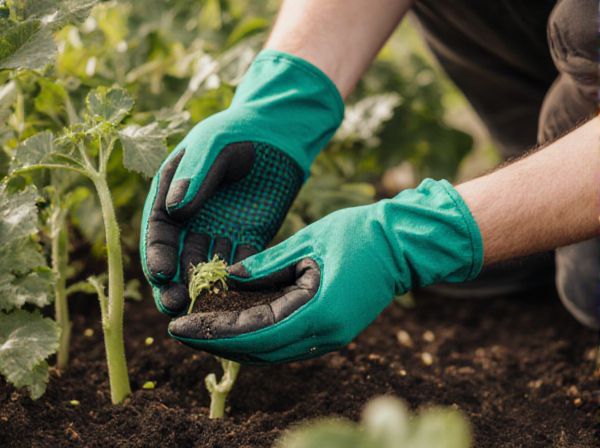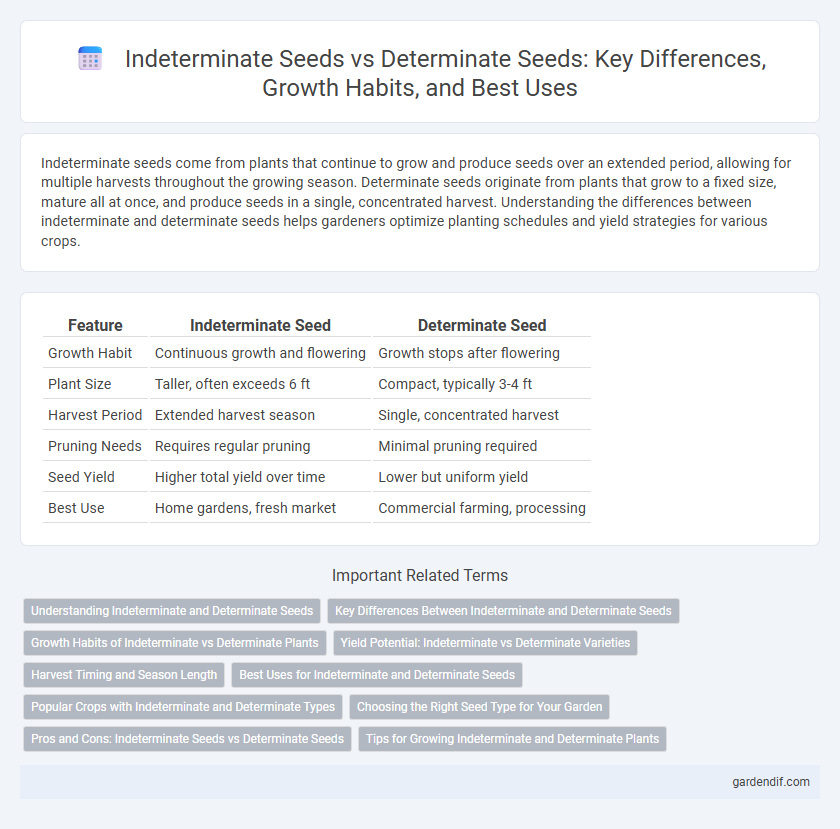
Indeterminate seed vs Determinate seed Illustration
Indeterminate seeds come from plants that continue to grow and produce seeds over an extended period, allowing for multiple harvests throughout the growing season. Determinate seeds originate from plants that grow to a fixed size, mature all at once, and produce seeds in a single, concentrated harvest. Understanding the differences between indeterminate and determinate seeds helps gardeners optimize planting schedules and yield strategies for various crops.
Table of Comparison
| Feature | Indeterminate Seed | Determinate Seed |
|---|---|---|
| Growth Habit | Continuous growth and flowering | Growth stops after flowering |
| Plant Size | Taller, often exceeds 6 ft | Compact, typically 3-4 ft |
| Harvest Period | Extended harvest season | Single, concentrated harvest |
| Pruning Needs | Requires regular pruning | Minimal pruning required |
| Seed Yield | Higher total yield over time | Lower but uniform yield |
| Best Use | Home gardens, fresh market | Commercial farming, processing |
Understanding Indeterminate and Determinate Seeds
Indeterminate seeds produce plants that grow and flower continuously until killed by frost, allowing for extended harvest periods and staggered fruit development. Determinate seeds result in plants with a fixed growth cycle, often maturing all fruit simultaneously, which facilitates single-time harvesting. Understanding the growth patterns of indeterminate versus determinate seeds aids in selecting appropriate crops for specific gardening goals and climate conditions.
Key Differences Between Indeterminate and Determinate Seeds
Indeterminate seeds produce plants that grow and yield fruit continuously throughout the growing season, extending harvest periods and supporting prolonged productivity. Determinate seeds result in plants that grow to a fixed size, mature quickly, and produce a concentrated harvest within a shorter timeframe. Understanding these key differences helps gardeners and farmers select the appropriate seed type based on growth habits, harvest timing, and crop management goals.
Growth Habits of Indeterminate vs Determinate Plants
Indeterminate seeds produce plants with continuous growth habits, generating new leaves and flowers throughout the growing season, resulting in extended harvest periods. Determinate seeds yield plants with a compact, bushy growth habit, where flowering and fruiting occur simultaneously and stop once the plant reaches maturity. This fundamental difference influences crop management, yield scheduling, and suitability for various cultivation environments.
Yield Potential: Indeterminate vs Determinate Varieties
Indeterminate seed varieties continuously produce flowers and fruit over an extended period, resulting in a prolonged harvest window and potentially higher total yield compared to determinate varieties. Determinate seed varieties mature all at once, leading to a concentrated yield with reduced labor for harvesting but a limited overall production span. Choosing between indeterminate and determinate seeds depends on desired yield volume, harvest timing, and management practices.
Harvest Timing and Season Length
Indeterminate seeds produce plants that continue to grow and yield fruit throughout the growing season, allowing for multiple harvests over an extended period, making them ideal for longer seasons. Determinate seeds result in plants that grow to a fixed size and produce fruit all at once, enabling a concentrated harvest suitable for shorter growing seasons. Choosing between indeterminate and determinate seeds depends on desired harvest timing and the length of the local growing season.
Best Uses for Indeterminate and Determinate Seeds
Indeterminate seeds are best used for crops requiring extended harvest periods, such as tomatoes and beans, where continuous fruit production is desired throughout the growing season. Determinate seeds are ideal for plants like bush beans and certain tomato varieties that produce a uniform, concentrated harvest, making them suitable for canning and bulk processing. Choosing between indeterminate and determinate seeds depends on the grower's goal for harvest timing and crop management efficiency.
Popular Crops with Indeterminate and Determinate Types
Popular crops with indeterminate seed types include tomatoes, cucumbers, and beans, which continue growing and producing fruit throughout the season. Determinate seed types are commonly found in crops like bush beans, certain pepper varieties, and determinate tomato cultivars, which grow to a fixed size and produce fruit all at once. Selecting between indeterminate and determinate seeds depends on cultivation goals, with indeterminate crops favoring extended harvest periods and determinate crops suited for mechanical harvesting and uniform yield.
Choosing the Right Seed Type for Your Garden
Indeterminate seeds produce plants that continue growing and fruiting throughout the season, ideal for gardeners seeking prolonged harvests and continuous yield. Determinate seeds result in plants that grow to a fixed size and produce all their fruit within a shorter period, perfect for those who prefer a concentrated harvest or have limited garden space. Selecting between indeterminate and determinate seed types depends on your garden goals, available space, and desired harvest timing.
Pros and Cons: Indeterminate Seeds vs Determinate Seeds
Indeterminate seeds produce plants that grow continuously and bear fruit throughout the growing season, offering higher yields but requiring more pruning and space management. Determinate seeds yield plants with a fixed growth period, resulting in a concentrated harvest that simplifies harvesting and reduces maintenance but limits total production. Choosing between indeterminate and determinate seeds depends on garden size, desired harvest duration, and resource availability.
Tips for Growing Indeterminate and Determinate Plants
Indeterminate plants continuously grow and produce fruit throughout the season, requiring consistent staking and regular pruning to encourage airflow and reduce disease risk. Determinate plants grow to a fixed size, concentrate their fruit production in a shorter period, and benefit from balanced watering and nutrient management to support a healthy, uniform harvest. For optimal growth, provide indeterminate varieties with tall support structures and avoid over-fertilizing determinate varieties to prevent excessive foliage growth at the expense of fruit production.
Indeterminate seed vs Determinate seed Infographic

 gardendif.com
gardendif.com